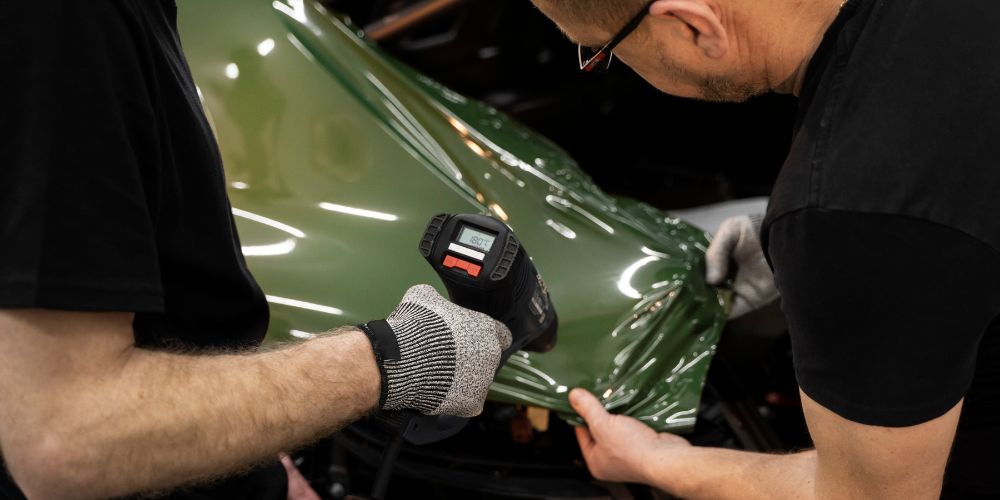5 Paint Protection Film Myths Debunked in 2024
Paint Protection Film (PPF) has become increasingly popular for vehicle owners seeking to preserve their car's exterior finish and maintain its resale value. However, despite its benefits, there are several myths surrounding PPF that continue to persist. In this blog, we'll debunk five common myths about PPF in 2024, shedding light on the truth behind these misconceptions.

Myth 1: PPF is Only for Luxury Vehicles
One prevalent myth about PPF is that it's exclusively reserved for luxury cars or high-end vehicles. However, this couldn't be further from the truth. While luxury car owners have long appreciated the protective qualities of PPF, the reality is that PPF is suitable for vehicles of all makes and models. Whether you drive a compact sedan, SUV, or sports car, PPF offers invaluable protection against chips, scratches, and other forms of damage.
Myth 2: PPF Makes Paint Maintenance Unnecessary
Some people believe that installing PPF eliminates the need for regular paint maintenance. While PPF provides additional protection for your vehicle's paint, other substitutes for proper care and maintenance exist. Regularly washing and waxing your car is still essential to keep your vehicle looking its best. PPF adds an extra level of defense against environmental hazards and road debris.
Myth 3: PPF is Permanent and Cannot be Removed
Contrary to popular belief, PPF is not a permanent addition to your vehicle's exterior. If you ever decide to remove the film, whether it's due to damage or aesthetic preferences, it can be safely and professionally removed without damaging your car's paint underneath. The removal process typically involves using heat and adhesive removers to lift the film off the paint's surface, leaving it unharmed.
Myth 4: PPF is Noticeable and Affects Vehicle Appearance
Many people assume that PPF will be visible and detract from the appearance of their vehicle. However, thanks to advancements in PPF technology, modern films are virtually invisible when properly installed by trained professionals. The film is designed to conform seamlessly to the contours of your car's body, protecting it without altering its appearance. Most people won't even notice that PPF is applied to your vehicle.
Myth 5: PPF is Expensive and Not Worth the Investment
While it's true that PPF installation is a bit costly, it's essential to consider the long-term benefits and cost-effectiveness of this protective solution. When compared to the potential cost of repainting or repairing damage to your vehicle's exterior, PPF can save you money in the long run. Additionally, many PPF providers offer flexible pricing options to suit different budgets, making it accessible to many vehicle owners.
Top 5 Types of Paint Protection Options for Your Vehicle
There are Different Types of Paint Protection available to protect your vehicle's car exterior, each having unique benefits and levels of protection:
1. Wax: Wax is one of the most traditional forms of paint protection. It typically comes in paste, liquid, or spray form and is applied to the vehicle's exterior surface. With its glossy finish, wax adds a layer of protection against minor scratches, UV rays, and contaminants. However, wax requires regular reapplication every few months to maintain its effectiveness.
2. Ceramic Coating: Ceramic coating forms a strong bond with the vehicle's factory paint, creating a protective layer. It offers excellent durability and shields against UV damage, oxidation, chemical stains, and water spots. The coating also creates a hydrophobic surface, repelling water and simplifying the vehicle cleaning process. Properly maintained ceramic coatings can last for several years, providing prolonged protection and a glossy finish.
3. Paint Protection Film (PPF): Paint protection film, also known as clear bra or clear film, shields the paint from chips, scratches, insect acids, and other environmental damage. It is self-healing, meaning that minor scratches and swirl marks can disappear over time when exposed to heat. PPF offers excellent protection for high-impact areas such as the front bumper, hood, fenders, and side mirrors.
4. Sealant: Paint sealants are synthetic polymer-based products designed to provide long-lasting protection for automotive paintwork. They offer enhanced durability compared to traditional waxes and provide superior resistance against UV rays, oxidation, acid rain, and environmental contaminants. Paint sealants create a slick, glossy surface that repels water and makes dirt and debris easier to remove during washing. While sealants may not offer the same level of protection as ceramic coatings, they provide a cost-effective and practical option for maintaining paintwork.
5. Nano Coating: Nanocoatings, also known as nano sealants or nano coatings, utilize nanotechnology to create an ultra-thin, transparent layer of protection on the vehicle's paint surface. Nanocoatings bond with the paint at the molecular level, forming a durable barrier that repels water, dirt, oil, and other contaminants. They provide excellent hydrophobic properties, making water bead up and roll off the surface, which helps prevent water spots and staining. Nanocoatings offer long-lasting protection and can last for up to two years or more with proper maintenance.
In conclusion, the myths surrounding Paint Protection Film (PPF) are often based on outdated information or misconceptions. By debunking these myths and highlighting the true benefits of PPF, We, Paint protection film Calgary hope to empower vehicle owners to make informed decisions about protecting their investments. Whether you drive a luxury car or a daily commuter, PPF offers unmatched protection and peace of mind on the road. If you're considering PPF for your vehicle, don't let these myths hold you back—invest in quality protection and preserve your car's beauty for years to come.